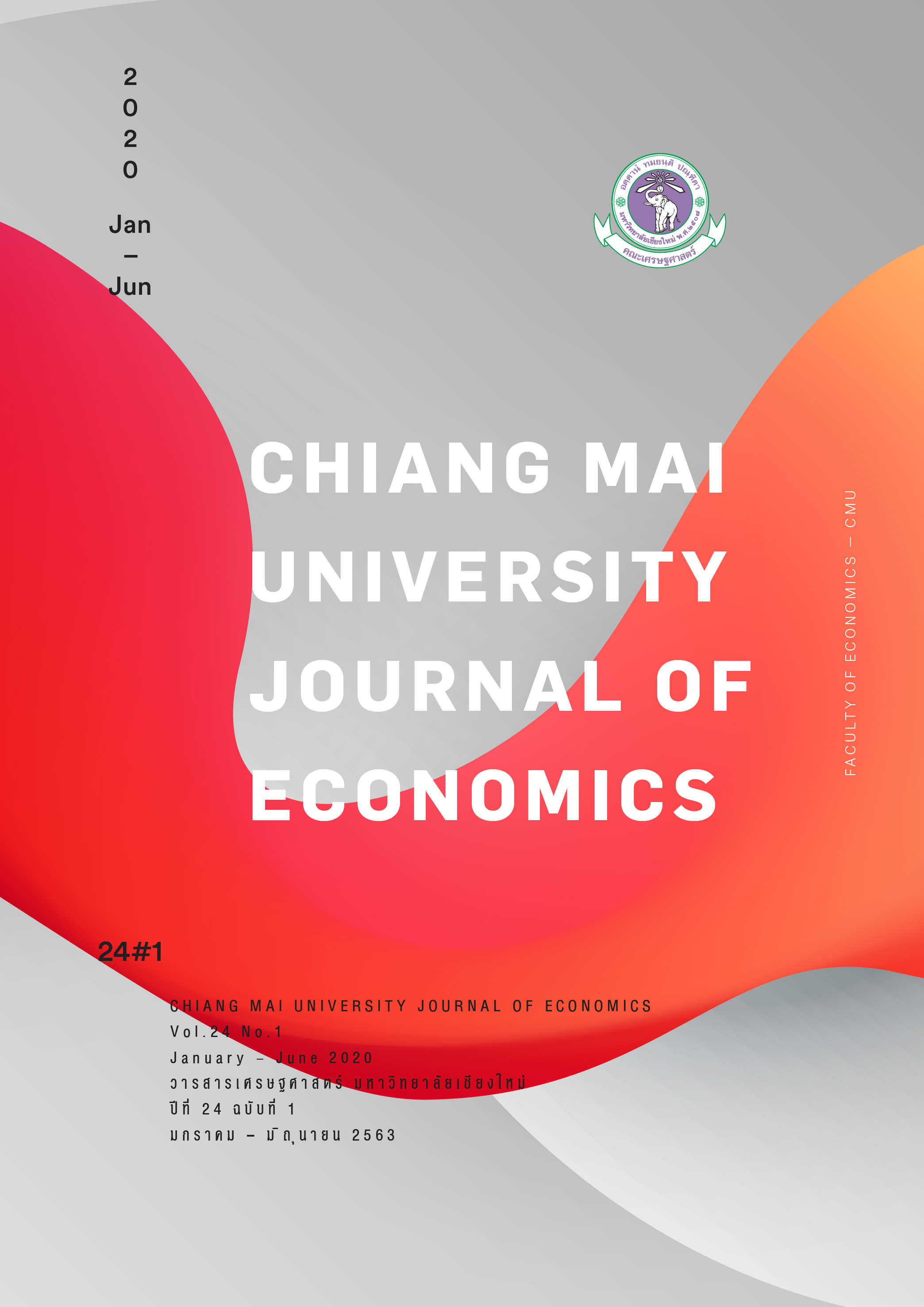ปัจจัยทางเศรษฐกิจมหภาคที่ส่งผลกระทบต่อมูลค่าการค้าชายแดนไทย-ลาว
คำสำคัญ:
มูลค่าการค้าชายแดนไทย-ลาว, ตัวแปรทางเศรษฐกิจมหภาคที่ใช้ในการศึกษาบทคัดย่อ
งานวิจัยนี้มีวัตถุประสงค์เพื่อศึกษาตัวแปรทางเศรษฐกิจมหภาคที่ส่งผลกระทบต่อมูลค่าการค้าชายแดนไทย-ลาว โดยจะทำการหาความสัมพันธ์ระหว่างตัวแปรทางเศรษฐกิจมหภาคที่เกี่ยวข้องจำนวน 7 ตัวแปร ได้แก่ มูลค่าการค้าชายแดนไทย-ลาว และตัวแปรทางเศรษฐกิจมหภาคอื่นๆ ได้แก่ อัตราแลกเปลี่ยนกีบต่อดอลลาร์สหรัฐฯ ดัชนีราคาผู้บริโภคของลาว และอัตราดอกเบี้ยเงินกู้ระยะสั้น 1 ปีของธนาคารแห่ง สปป.ลาว และอัตราแลกเปลี่ยนบาทต่อดอลลาร์สหรัฐฯ และดัชนีราคาผู้บริโภคของไทย และอัตราดอกเบี้ยเงินกู้รายย่อยลูกค้าชั้นดีของธนาคารแห่งประเทศไทย ซึ่งจะใช้ข้อมูลสถิติรายเดือน ระหว่างเดือนมกราคม พ.ศ. 2550 ถึงเดือนธันวาคม พ.ศ. 2561
โดยกำหนดสมมุติฐาน ไว้ 2 ประเด็น คือ ตัวแปรทางเศรษฐกิจมหภาคแต่ละตัวแปร มีผลกระทบต่อมูลค่าการค้าชายแดนไทย-ลาวด้วยขนาดที่ไม่เท่ากัน และการเปลี่ยนแปลงของอัตราแลกเปลี่ยนเงินบาทต่อดอลลาร์สหรัฐฯจะมีผลกระทบต่อมูลค่าการค้าชายแดนไทย-ลาวมากกว่าตัวแปรอื่นที่ใช้ในการศึกษา
ผลการศึกษาโดยใช้แบบจำลองความสัมพันธ์ของตัวแปร Vector Autoregressive (VAR) พบว่าเป็นไปตามสมมุติฐานที่ 1 เนื่องจากเมื่อเกิดการเปลี่ยนแปลงขึ้นกับตัวแปรที่ใช้ในการศึกษาแต่ละตัวแปรจะมีผลกระทบต่อมูลค่าการค้าชายแดนไทย-ลาว ทั้งในทิศทางเดียวกันและในทิศทางตรงกันข้ามกันด้วยขนาดที่ไม่เท่ากัน แต่ผลกระทบดังกล่าวอยู่ในระดับที่น้อยมาก และพบว่าไม่เป็นไปตามสมมุติฐานที่ 2 เนื่องจากอัตราแลกเปลี่ยนบาทต่อดอลลาร์สหรัฐฯมีผลกระทบต่อมูลค่าการค้าชายแดนไทย-ลาวน้อยที่สุดเมื่อเทียบกับตัวแปรอื่นที่ใช้ในการศึกษา
เอกสารอ้างอิง
Bank of the Lao PDR. (2019). The statistical report for Q1 2019. Retrieved from www.bol.gov.la
Division of Trade and Investment Cooperation. (2017). Statistics of border trade and border trade in Thailand 2015 - 2017. https://www.m-society.go.th/ewtadmin/ewt/mso_web/article_attach/19325/20679.pdf
Dwyer, G. P. (2015). The Johansen Tests for Cointegration. http://www.jerrydwyer.com/pdf/Clemson/Cointegration.pdf
Enders, W. (1948). Applied econometric time series. https://www.academia.edu/25270301/Applied_Econometrics_Time_Series_4th_edition
Financial Institution Development Fund. (2016). Annual Report 2016. from Bank of Thailand https://www.bot.or.th/Thai/FinancialInstitutionsDevelopmentFund/About_FIDF/DocLib_Report/ReportFIDF2559.pdf
Gutiérrez, C. E. C., Souza, R. C., & Guillén, O. T. d. C. (2007). Selection of Optimal Lag Length in Cointegrated VAR Models with Weak Form of Common Cyclical Features. Retrieved from Central Bank of Brazil: https://www.bcb.gov.br/pec/wps/ingl/wps139.pdf
Natakit Karnkiangkai. (2015). The Relations between ETRON Index and Economic Factors: VAR Model. Bangkok University, Bangkok University.
Pattarasuda Susaen. (2005). A COMPARISION OF MODEL SELECTION CRITERIA ON LINEAR REGRESSION WITH SMALL SAMPLE SIZE. Chulalongkorn University, Retrieved from cuir.car.chula.ac.th/bitstream/123456789/6719/1/Pattarasuda_Su.pdf
Royal Thailand Embassy Vietiane Laos PRD. (2010). 60-year Relationship Thailand - Laos. http://www.thaisavannakhet.com/vientiane/th/60years_thai-laos/
Toda, H. Y., & Phillips, P. C. B. (1994). Vector Autoregressions and Causality: A Theoretical Overview and Simulation Study.
ดาวน์โหลด
เผยแพร่แล้ว
ฉบับ
ประเภทบทความ
สัญญาอนุญาต
All opinions and contents in the CMJE are the responsibility of the author(s). Chiang Mai University Journal of Economics reserves the copyright for all published materials. Papers may not be reproduced in any form without the written permission from Chiang Mai University Journal of Economics.
ข้อคิดเห็นที่ปรากฏและแสดงในเนื้อหาบทความต่างๆในวารสารเศรษฐศาสตร์มหาวิทยาลัยเชียงใหม่ ถือเป็นความเห็นและความรับผิดชอบโดยตรงของผู้เขียนบทความนั้นๆ มิใช่เป็นความเห็นและความรับผิดชอบใดๆของวารสารเศรษฐศาสตร์ มหาวิทยาลัยเชียงใหม่
บทความ เนื้อหา และข้อมูล ฯลฯ ในวารสารเศรษฐศาสตร์มหาวิทยาลัยเชียงใหม่ ถือเป็นลิขสิทธิ์เฉพาะของคณะเศรษฐศาสตร์มหาวิทยาลัยเชียงใหม่ หากบุคคลหรือหน่วยงานใดต้องการนำทั้งหมดหรือส่วนหนึ่งส่วนใดไปเผยแพร่ต่อหรือเพื่อกระทำการใดๆ จะต้องได้รับอนุญาตเป็นลายลักษณ์อักษร จากวารสารเศรษฐศาสตร์ มหาวิทยาลัยเชียงใหม่






